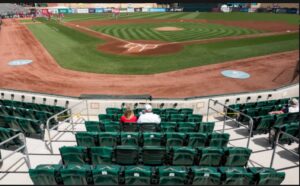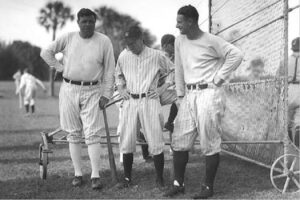by Paul Langendorfer

Every year without fail, it happens. Sometimes earlier, sometimes later, but the yearn to watch the game starts. We wait for the snow to melt, for the grass to appear, thinking of how it will become green and reminds us of our favorite place in the world. The perfect emerald green of a baseball diamond. Soon we will hear those magic words that come every February—“Pitchers and catchers report!”
We take out the old mitt that has been stored away for a few months now, maybe under a mattress with a ball in it to form that perfect pocket that will SNAP when the ball hits it and not move again. Back and forth the ball travels between the hand and the mitt, like the pendulum of a clock counting down the time until you can hit the diamond or go out and play catch with your friends, your father, or the nearest wall.

Baseball is more than a game to those of us who view it as a quasi religion of sorts. It is a reminder of what is and what has been. Each and every person has a memory of the game, be it as a player or as a spectator or as both. A memory of a loved one passed on or someone standing right there with you. The joy of watching your favorite player hit a mammoth home run into the deepest reaches of the park.
Maybe it is your own memory of chasing down the perfect white sphere, tracking it and watching it land in your glove in Little League for the final crucial out of the game.
These memories are what make the game timeless. It is a game accessible to everyone at every age. You only need a ball or spherical object and a bat or stick in the stickball days to make a game happen. And then you became the hero in Game Seven of the World Series every time you played.
The start of the season is when it hits us the hardest, those memories. It is a rebirth: Spring Training and Opening Day. Summer is coming with its heat, long days, and hot, sticky nights, hopefully under the lights somewhere watching our game. I have attended hundreds of games in my life with friends and family.

Here in Buffalo, I remember seeing the Bisons take the field in the cavernous stadium that was War Memorial, but have also sat rapt and listened as my father told me of the perfection of Offerman Stadium and how Opening Day was a holiday when kids missed school.
My grandfather passed away when my father was only nine years old, but to the very end my father remembered being taken out of school to visit old Offerman with his father on that perfect day and watching his hero, the late great Ollie Carnegie, dance around the base paths.
For me it was not always about Opening Day but about the weeks leading up to it. There is something to be said for the intimacy of Spring Training, of watching your larger than life baseball hero in a small bandbox of a stadium.
I remember walking around the corner in Dunedin, Florida and watching the great Hall of Fame pitcher Steve Carlton warming up before the game in a tiny pitching cage designed for what looked like a little leaguer. Years later I had the opportunity to meet “Lefty” personally and spoke to him about that stadium and the familiarity it afforded fans such as myself.
For many years my father and I would travel to Florida to run part of the “circuit” and attend games in Dunedin (Blue Jays), Clearwater (Phillies), Port Charlotte (Rays) and of course Tampa, home of my beloved Yankees. I think my father always detested that one, as he was a refined Yankee hater to his dying day. I always thought it was an oxymoron that the man was born in 1927, the year of one of the greatest Yankee dynasties ever, and would live to love to hate the team. It is the specter of that great 1927 team that leads me to my favorite Spring Training recollection.

Many years ago in one of those Spring Training trips, we took a most wonderous detour to visit a little known shrine to baseball in the St. Petersburg, Florida sun. I had read that the original Spring Spring Training home of those early Yankee teams still stood and was known as Huggins-Stengel Field, in honor of two of the greatest Yankees managers.
Originally built in 1925 and known at that time as Crescent Lake Field, it sits in relative obscurity despite being named to the National Register of Historic Places in 2019. Only a few miles from the modern day home of the Tampa Bay Rays, my father and I had little difficulty finding it. I expected a fence and a lock to keep me away but was shocked that the field was open and beckoning us to come join the ghosts of the past, my own Field of Dreams.
It is rumored that Casey Stengel’s ghost himself has made an appearance at the stadium. It has been home to the Yankees from 1925-1961, the crosstown Mets from 1962-1987, and the Baltimore Orioles from 1992-1995. What makes the field special is that over the stretch of its nearly 100 years it has not been altered in its dimensions or raised or lowered to accommodate for the modern era. Walking on that field is walking where legends walked and trained.

As I strode out to the deepest part of the park, looking at Crescent Lake, and
turned to view the dot of home plate some 500 feet away, I thought of the Hall of Famers and their ilk that had inhabited this “hallowed” ground. Supposedly Babe Ruth and Mickey Mantle were some of the only players to hit a ball into the lake. I chuckled at the thought of Babe not wanting to shag flies due to the alligators sunbathing on the edge of the lake.
I stood there in right field where he had stood, on the same grass, the same patch of earth where he ran down fly balls, and just soaked in the timelessness of the place. I wiped the grass with my Yankees cap, embedding the emerald green into the hue of navy blue.
As I made my way back to the dugout, a collegiate team had showed up for practice. Feeling like a child, I walked up to a player and asked him if I could borrow a ball. He smiled at me and tossed me a beat-up baseball. I remember running up to my father and standing where first base was, the same mud that Lou Gehrig stood upon as a healthy young bull in that spring of 1927, and the fateful year of 1939, when he began to feel weak from the beginning of Amyotrophic Lateral Sclerosis (ALS) the disease that would kill him and would bear his name thereafter.
I looked at my father and said those words that every boy has said in his life at least once, “Dad, let’s have a catch!” We threw the ball around barehanded like the players of old, tentatively at first and then with more gusto, laughing in the Florida sun, and swearing at our missed throws. I always wondered if the collegiate boys understood. I think they did; they knew what it was about.

After a few moments, it was time to let the real athletes reclaim their field. I wiped the ball
in the timeless mud of the field, and then added that dirt to my now soiled Yankees cap as well.
Iasked the ballplayer if I could keep the ball and he obliged. He understood it was so much more than just an old ordinary baseball now. It held the dirt of legends on it, the sweat of a father and a son, a relic of a moment in time that will never fade away. We signed the ball that afternoon, him and I.
My father passed away several years ago, but next to my signed Steve Carlton baseball, is our ball. My father’s signature on that beat up ball is my most treasured autograph of all.

Paul Langendorfer is an avid sports fan with a deep passion for the National Pastime, especially when it comes
to the New York Yankees. Born and raised in Buffalo, New York, Paul holds a B.A. from Canisius College, a M.A.
from the University of Colorado at Denver. He is the author of the book Baseball in Buffalo.He was a contributor
to the Seasons of Buffalo Baseball 1857-2020, published by Billoni Associates Publishing. Paul currently resides in
Buffalo with his wife and two children.
